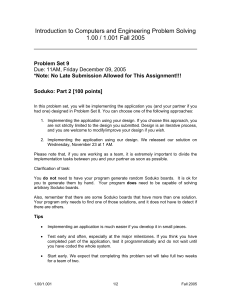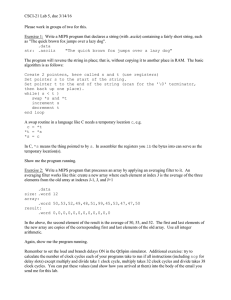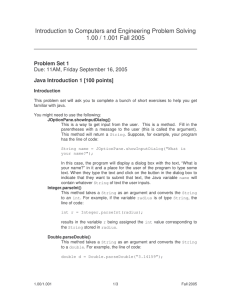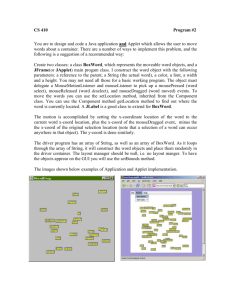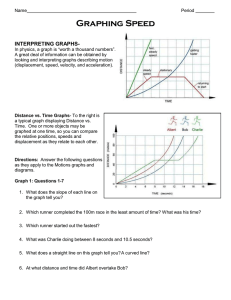Introduction to Computers and Engineering Problem Solving Problem Set 3
advertisement
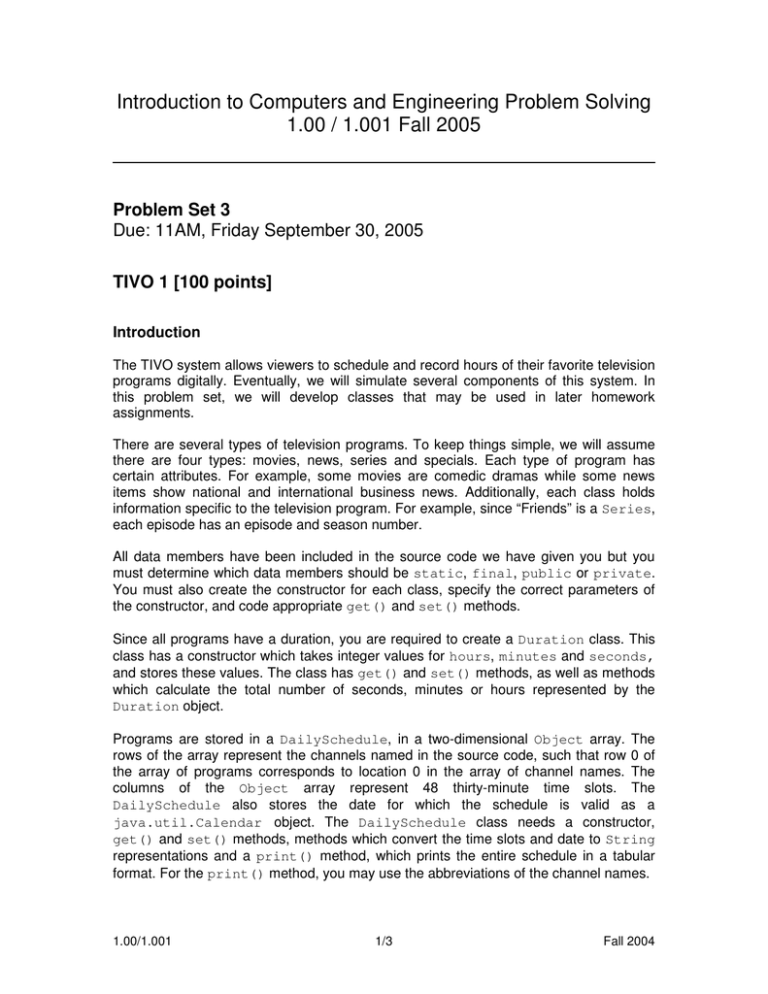
Introduction to Computers and Engineering Problem Solving 1.00 / 1.001 Fall 2005 Problem Set 3 Due: 11AM, Friday September 30, 2005 TIVO 1 [100 points] Introduction The TIVO system allows viewers to schedule and record hours of their favorite television programs digitally. Eventually, we will simulate several components of this system. In this problem set, we will develop classes that may be used in later homework assignments. There are several types of television programs. To keep things simple, we will assume there are four types: movies, news, series and specials. Each type of program has certain attributes. For example, some movies are comedic dramas while some news items show national and international business news. Additionally, each class holds information specific to the television program. For example, since “Friends” is a Series, each episode has an episode and season number. All data members have been included in the source code we have given you but you must determine which data members should be static, final, public or private. You must also create the constructor for each class, specify the correct parameters of the constructor, and code appropriate get() and set() methods. Since all programs have a duration, you are required to create a Duration class. This class has a constructor which takes integer values for hours, minutes and seconds, and stores these values. The class has get() and set() methods, as well as methods which calculate the total number of seconds, minutes or hours represented by the Duration object. Programs are stored in a DailySchedule, in a two-dimensional Object array. The rows of the array represent the channels named in the source code, such that row 0 of the array of programs corresponds to location 0 in the array of channel names. The columns of the Object array represent 48 thirty-minute time slots. The DailySchedule also stores the date for which the schedule is valid as a java.util.Calendar object. The DailySchedule class needs a constructor, get() and set() methods, methods which convert the time slots and date to String representations and a print() method, which prints the entire schedule in a tabular format. For the print() method, you may use the abbreviations of the channel names. 1.00/1.001 1/3 Fall 2004 The ProblemSet3 class contains a getDailySchedules() method that generates an array of DailySchedule objects. The length of this array is specified by you. You must generate and print one DailySchedule, showing the schedule’s date and showing all programs, channels and times. Assignment Create or modify the Movie, News, Series, Special, Duration, DailySchedule and ProblemSet3 classes provided in a zip in the assignments section, as follows: Movie, News, Series, Special • Determine the access modifiers for all data members (public/private). Also determine whether data members are static and/or final. • Create constructors with values for the appropriate data members as arguments. • Create get() and set() methods for the appropriate data members. Duration • Create the Duration class. This class has data members for hours, minutes and seconds. • Create get() and set() methods for the data members. • Write a getTotalInHours() method which converts the total time represented by the Duration object to a double value representing hours. For example, 1 hour 30 minutes would become 1.5 hours. Do the same for getTotalInMinutes() and getTotalInSeconds() methods. • Write a toString() method that creates a String representation of the values represented by the Duration object. DailySchedule • Create a constructor which takes a Calendar object (date) and an Object array (programs) as arguments. • Generate get() and set() methods for the appropriate data members. • Write a static dateToString() method which converts a date (Calendar) to a String. • Write a static channelNumberToName()method which converts the row number representing the channel into the channel name. • Write a static timeSlotToTime() method which converts a time slot (0 through 47) into a time (String). This method should allow either a 12 hour or 24 hour format. • Write a print() method which takes no arguments and returns nothing but prints a tabular representation of the DailySchedule object Rows represent channels; columns represent times. The date of the schedule must be printed prominently. To help you, a formatTo20Chars() method has been provided. This method takes a String as an argument and returns a String that is 20 characters long. ProblemSet3 • Generate and print a DailySchedule in the main() method. 1.00/1.001 2/3 Fall 2004 Turn In • Turn in electronic copies of all source code (.java files). No printed copies are required. • Place a comment with your full name, MIT server username, tutorial section, TA’s name, and assignment number at the beginning of all .java files in your solution. • Remember to comment your code. Points will be taken off for insufficient comments. • Place all of the files in your solution into a single zip file. Submit this single zip file under the appropriate section and problem set number. • Your solution is due at 11AM. Your uploaded files should have a time stamp of no later than 11AM on the due date. • Do not turn in compiled byte code (.class files) or backup source code (.java~ files). Penalties • 30% off If you turn in your problem set after 11AM on Friday but before 11AM on the following Monday. • No Credit If you turn in your problem set after 11AM on the following Monday. 1.00/1.001 3/3 Fall 2004

